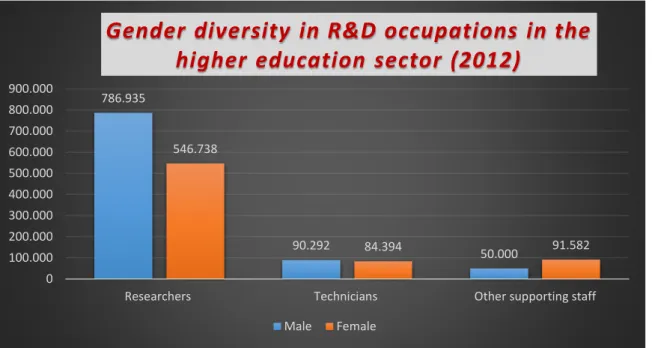The purpose of the Dissertation is to investigate the impact of gender diversity on firm performance. Return on equity (ROE) and return on assets (ROA) are used as dependent variables to determine whether gender diversity has an impact on firm performance. The aim is to test the statistical significance between the two groups and to generalize the results for all 86 companies in the sample.
Finally, gender diversity has a positive effect on firm performance in the Greek listed companies as measured by ROA but not as measured by ROE.
Introduction
The aim of the thesis is to investigate the impact of gender diversity on the performance of companies. Evidence from previous research shows that female managers are underrepresented in boardrooms and, despite the gradual improvement in the situation, most companies are male-dominated. The dissertation's methodology is quantitative research with the collection of secondary data from the published annual reports and group accounts for 84 companies.
Financial information is used to calculate Return on Equity (ROE) and Return on Assets (ROA) indicators.
Theoretical Background
Split labor market and the Gender Gap
- Glass Celling Theory
- Biological, Socialization and Structural/Cultural Models
Gender differences are inherently included in the social fabric of different cultures and societies and different types of comparisons take place, preventing women from reaching the top (Bombuwela and De Alwis, 2013). Biological gender differences may be responsible for sickness-related absenteeism differences between men and women. Structural-cultural models are commonly used to estimate or explain gender differences in work settings.
Social structures and systems determine gender differences due to differences in status and power (Liden, 1985).

Effects of Gender Gap
- Gender pay gap
- Effects on firm performance
- Gender Gap and Industry
- Gender Gap and Firm Size
Finally, there are differences in the wage gap between the public and private sector wage distribution. The results prove that there is a negative relationship between gender diversity on boards and the level of information asymmetry in the stock market. Therefore, gender diversity can lead to inefficiency in the decision-making process and conflicts in the boardroom.
In the banking sector, women's representation in the BOD is low across all geographic regions.

Financial analysis tools
- Financial Analysis
- Key Performance Indicators
- Measuring Firm Performance
- Return on Equity (ROE)
- Return on Assets (ROA)
Another important financial KPI is the current ratio, which measures a company's liquidity by dividing current assets by current liabilities. Management sets goals and objectives that take into account all aspects of the company's operations and encompass the company's mission and vision. This step involves identifying the changes that have occurred in the company's numbers over a specific time frame.
Performance measurement deals with the method of measuring a company's effectiveness and efficiency of actions (Neely et.al., 2005). ROE is generally seen as a measure of how effectively management can use the company's equity to generate profits. The general assumption is that management wants to increase the company's ROE by using its equity capital.
Prudent management is likely to yield a higher ROE, but maintaining appropriate values of equity or net income is a challenging managerial task that requires a thorough understanding of the firm's activities. However, it is also necessary to perform trend analysis and see how a firm's ROE changes over time and why. Return on assets (ROA) is a profitability ratio that provides an indication of a firm's performance based on the profits a firm generates using its total assets.
ROA is an excellent metric of financial performance because it considers a company's total assets used to support its operations and determines whether the company can produce an adequate return on those assets, rather than simply showing a strong return on sales. Although ratio analysis can be useful in a company's business and financial situation, it also has some limitations.
Data Description and Methodology
- Data Description
- Descriptive statistics
- Linear regression analysis
- Correlation analysis
- Hypothesis testing
Women represent 2.1% in the car rental sector, 2.8% in the trade (miscellaneous goods) sector and 2.1% in the life insurance sector. The highest male participation (12.4%) is in the Various sectors where the highest female participation (5.5%) is also observed. The highest male participation (7.6%) is in the Pharmaceuticals sectors, which also has the highest female participation (4.1%).
In a linear relationship, for every change in the variable X by one unit, the variable Y changes by b. A positive correlation coefficient of r=1 means that both variables are positively correlated and their values change in the same direction, that is, when the values of one variable increase, the values of the other variable also increase. A negative correlation coefficient of r=-1 means that the two variables are negatively correlated and their values change in the opposite direction, i.e. when the values of one variable increase, the values of the other variable decrease.
Null hypothesis H01: There is no relationship between gender and ROE in the Greek listed companies. Null hypothesis H02: There is no relationship between gender and ROA among the Greek listed companies. Null hypothesis H03: There is no relationship between gender and company size among Greek listed companies.
Alternative hypothesis H3: There is a relationship between gender and firm size in the Greek listed firms. Therefore, if the null hypothesis H01 is accepted, it means that gender diversity has a positive effect on firm performance in the Greek listed companies as measured by ROE.

Data Analysis and Results
- Regression analysis results for each Group
- Correlation analysis results for each Group
- Aggregate regression analysis results
- Aggregate correlation analysis results
Therefore, the relationship between the dependent variable ROE (y1) and all independent variables x1 to x5 is not statistically significant in Group A. Therefore, the relationship between the dependent variable ROA (y2) and the independent variables x3 - Firm size and x4 - Sector is statistically significant in Group B (Table 4-3). We tested the correlation coefficients between the dependent variable ROE (y1) and the independent variables x1 to x5 for Group A.
We tested the correlation coefficients between the dependent variable ROA (y2) and the independent variables x1 to x5 for Group A. We tested the correlation coefficients between the dependent variable ROE (y1) and the independent variables x1 to x5 for Group B. The results show that there is a negative yet weak correlation between ROE and all independent variables.
We tested the correlation coefficients between the dependent variable ROA (y2) and the independent variables x1 to x5 for group B. The results show that there is a negative but weak correlation between ROA and all independent variables. The aggregated regression results for the entire sample show no statistical significance between dependent variable ROE (y1) and all independent variables x1 to x5 as p-values are higher than 0.05.
The total regression results for the entire sample show that the relationship between dependent variable ROA (y2) and variable x1 – Gender is statistically significant as p = 0.017. Regarding t-statistics, results for both dependent variables ROE (y1) and ROA (y2) show that the estimated coefficients are statistically different from zero and therefore statistically significant (Table 4-8).

Discussion of Results
Statistical analysis results
Correlation analysis showed a positive but weak correlation between ROE and gender (r=0.08393) and ROE and the number of executives in the BOD (r=0.03086). Furthermore, Hansen et.al (2016) argue that although gender diversity in top management may be associated with higher financial performance, the findings cannot be generalized to gender diversity in the boardroom. Evidence from Dutch and Danish boardrooms in a sample of 186 listed companies observed in 2007 shows that 40% of these companies have at least one woman in the boardroom, representing up to 5.4% of the total number of executives in the board of directors.
Drawing on a sample of Asian firms from Hong Kong, Malaysia, Singapore and South Korea, Low et.al. 2015) show that increasing participation of female executives in the BOD has a positive effect on firm performance, as measured by ROE. Also, the increasing percentage of women in the boardroom has a substantial impact on economic performance as measured by ROE and ROA. Evidence from the largest European companies listed in the STOXX Europe 600 Index for 2016 shows that gender nationality and age diversity all have a positive impact on firms' financial performance (Woschkowiak finds a positive correlation between increasing the number of women on the Board of Directors and the firm's economic performance.
Empirical evidence from Spanish firms shows that the presence of women in the BOD can increase ROA and return on sales with further ethical and social consequences (Isidor and Sobral, 2015), while evidence from the Spanish technology sector shows that although the sector is male dominated, gender diversity is strongly and positively correlated with innovation and improved organizational performances (Ruiz-Jiménez and del Mar Fuentes-Fuentes, 2016). In the Israeli information technology sector, the presence of women in the BOD is negatively correlated with earnings management. Men are typically more aggressive in accounting practices and the increasing percentage of women in the BOD and/or the audit committee does not favor accounting aggressiveness.
2015) examine gender diversity in UK technology companies and argue that the presence of women on company boards has a strong impact on earnings management practices. Also, the management styles of men and women show several similarities, while at the same time the presence of women in the BOD is associated with better leadership and organizational results.
Conclusions and Recommendations
General conclusions
H02 is rejected and the alternative hypothesis H2 is confirmed - there is a relationship between gender and ROA in the Greek listed firms. Correlation analysis showed a positive correlation between ROE and Gender (r=0.08393) and ROA and Gender (r=0.08775), although both correlations are weak. Pooled correlation results showed a negative correlation between ROE and Gender (r=-0.03524) and a positive correlation between ROA and Gender (r= 0.11378).
Limitations of the study
Suggestions and recommendations
The gender and ethnic diversity of U.S. boards and committees and corporate financial performance. Board gender diversity and corporate performance: Empirical evidence from Hong Kong, South Korea, Malaysia and Singapore. IPO company performance and its association with executive gender, family ties, and other demographics.
Managerial capabilities, innovation and gender diversity in the top management team: an empirical analysis in technology-based SMEs. Women in the boardroom and corporate financial performance: Evidence from the Nasdaq OMX Helsinki companies. The double-edged nature of board gender diversity: Diversity, firm performance, and female director power as predictors of strategic change.
The relationship between investment in information technology and firm performance: A study of the valve manufacturing sector.







